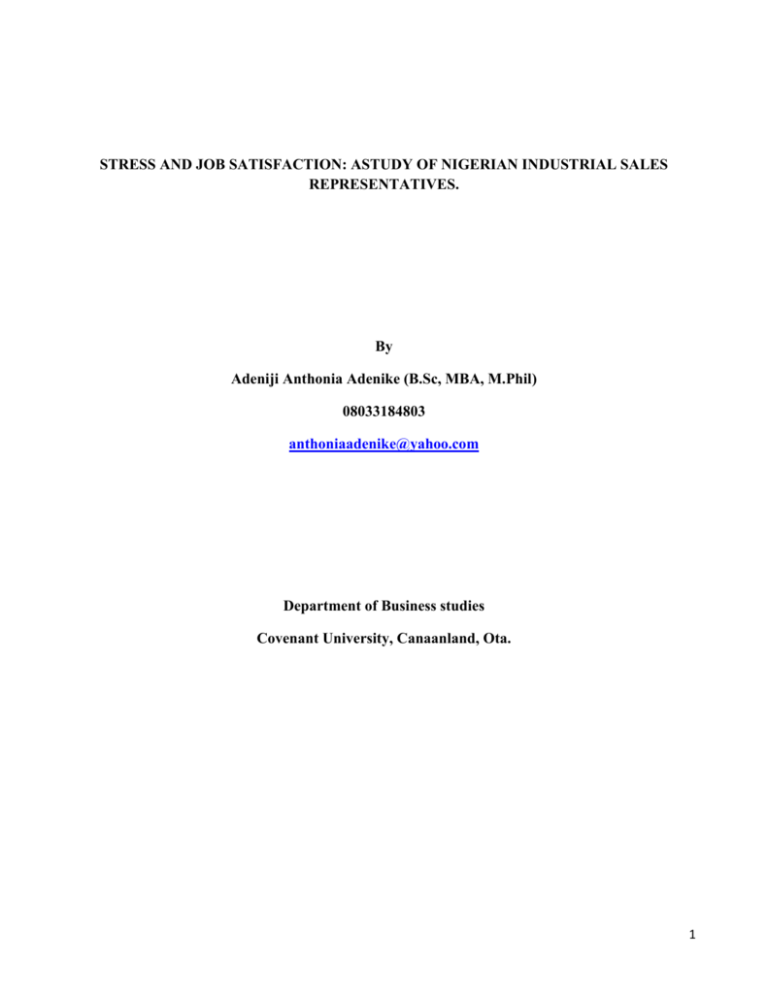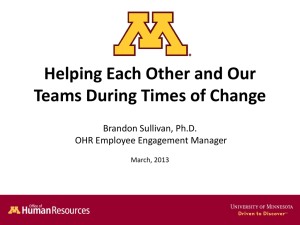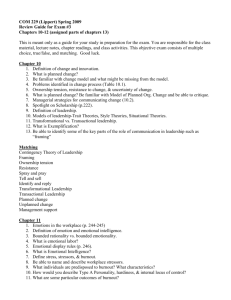- Covenant University Repository
advertisement

STRESS AND JOB SATISFACTION: ASTUDY OF NIGERIAN INDUSTRIAL SALES REPRESENTATIVES. By Adeniji Anthonia Adenike (B.Sc, MBA, M.Phil) 08033184803 anthoniaadenike@yahoo.com Department of Business studies Covenant University, Canaanland, Ota. 1 STRESS AND JOB SATISFACTION: A STUDY OF NIGERIAN INDUSTRIAL SALES REPRESENTATIVES. Abstract This paper reviews the burnout consequences on job satisfaction among the industrial sales representatives. The basic issue of concern is that job satisfaction responds to the different consequences of burnout regarding industrial sales representatives. In achieving this objective ,the survey instrument (questionnaire) is used in the collection of data. Some of the questions asked centered on the consequences of burnout on job satisfaction. Based on the data obtained from the respondents it was observed that some components of job satisfaction mainly job context and promotion could predict levels of burnout. The other components namely- supervision, coworkers, and pay do not predict burnout which confirm the findings of Leiter and Maslach, (2005) who suggest that there are certain variations on how the components of job satisfaction predicts burnout. The findings show that understanding of the complexity associated with initiative of finding out the likely consequences of burnout on job satisfaction of Nigerian industrial sales representatives is needful which further pointed to the fact that organization should consistently evaluate the components of job satisfaction in a manner that satisfies employees, e.g. by ensuring that a promotion policy be in place that offers employees excellent chances of promotions. Secondly, that the manner in which the sales representatives can progress in the industry need to be clear to all sales persons which correspond to the thinking of Weallens, (2003). Keywords: Job satisfaction, Burnout, Mental Exhaustion, Depression, Organizational dysfunction and climate, Personality dysfunction, Cynicism, detachment from job. 2 Introduction: The relationship between job satisfaction and burnout is well researched in the literature. Most of the studies concluded that burnout and job satisfaction are inversely related (James and Tetrick, 2006; Griffith, 2003) Job satisfaction has traditionally been studied predominantly on the basis of how it influences performance or production of labor. According to (Fletcher and Williams, 2006), job satisfaction has hardly been studied on sales driven jobs. Burnout however has been studied as a consequence of the degree of organizational dysfunction or personality dysfunction (Morrisette, 2004). Not only that many of the research that has been conducted on burnout has centered on the helping professions such as teachers, nurses, physicians, social workers, therapists and police (Ivancevich & Matteson, 2005) .Literature review suggest that little work had been done on customer services agents, salespersons and related professions (Leiter & Maslach, 2005). Thus this paper will determine whether job satisfaction is a predictor of burnout among industrial sales representatives. Methodology The literature review on both the independent variable (job satisfaction) and the dependent variable (burnout) will be presented according to the humanistic paradigm (Brabson, 1991). The humanistic paradigm is characterized by two basic assumptions, which distinguish both its methodology and its theories from other approaches; the focus on subjective experience (Phenomenological view point) and a rejection of determinism in favor of individual choice. The empirical study will be presented from the functionalistic paradigm. This perspective is based upon the assumption that society has concrete, real existence with a systematic character oriented to produce an ordered and regulated status quo, (Savicki, 2002). The paradigm focuses on the functioning of the psyche, adaptation to environment and individual differences: The research design involves a literature review and an empirical investigation to determine the predictive value of job satisfaction for burnout. For the purpose of this paper, job satisfaction will be the dependent variable and burnout will be the dependent variable. The study will also be confined to the individual level of analysis. A random sample of 139 participants comprising of medical sales representatives are selected and questionnaire including the job descriptive index and burnout index administered to them and justified as instruments to assess job satisfaction and burnout. The following are the research questions; - What does job satisfaction mean and what constructs are involved? - What does burnout mean and what constructs are involved? - Is there a theoretical relationship between job satisfaction and burnout? - Can job satisfaction act as a predictor of burnout among medical sales representative? - What are the levels of job satisfaction and burnout among medical sales representative? - What recommendations can be made for the management of job satisfaction and burnout? However, these are the hypothesis formulated for the study: 3 H0: Job satisfaction does not predict burnout H1: Job satisfaction predicts burnout H0: There is no significant correlation between job satisfaction and burnout. H1: There is significant correlation between job satisfaction and burnout The reliability and validity in this study is ensured through: The selection of models and theories in a representative manner and presented in a standardized manners The selection of standardized measuring instrument in a responsible way and presented in a standardized manner. The external validity and reliability is further ensured by the random selection of the sample to be representatives of the total population of sales representatives in industrial companies. Moreover for this research, job satisfaction will be conceptualized according to its multiaspectsal, namely: pay, work, promotion, supervision and co-worker, (Morrissette, 2004). Burnout will be conceptualized according to its three key aspects namely exhaustion, cynicism and detachment from job (Savicki, 2002). Theoretical Framework/ Literature Review On examining the relevant literature on job satisfaction, some authors appear to use the terms “job satisfaction” and “innovation” interchangeably. However, the two concepts can also be viewed as separate concepts. Motivation can be defined as a persistent effort directed towards a goal, (Wealleans, 2003). On the other hand, job satisfaction refers to a collection of attitudes that workers have towards their jobs. Many are the definitions of job satisfaction. Most authors define job satisfaction in terms of feelings, attitudes and beliefs that people have about their current jobs. (Robbins et al, 2003) define job satisfaction as a subjective measure of worker attitudes - that is an individual’s general attitude to his or her job. A person with high job satisfaction holds positive attitude towards the job and one who is dissatisfied with it has negative attitudes towards it. Also suggests that if an employee’s attitude is wrong, he or she will not experience job satisfaction. (Ivancevich and Matteson, 2005) define job satisfaction as an attitude that individuals have towards their jobs which stems from their perception of their jobs and the degree to which there is a good fit between the individual and the organization. Some authors define job satisfaction in terms of the way people react to their work environment. (Alderfer, 2000) for example sees job satisfaction as “the difference between the amount of some valued outcome a person receives and the amount of that outcome’. Thus an employee becomes dissatisfied when things are not the way they should be. (Riffle, 1999) agrees with the above definition by suggesting that in general, job satisfaction appears to be determined by the difference between the amounts of that outcome he or she feels should be received. Hence, the larger the discrepancy, the greater the dissatisfaction will be. Not only that, it is also defined in terms of needs and (Leiter& Maslach, 1988) for instance, sees it as a consequence of the workers experience on the job in relation to his value, that is, to what he wants or expects from it. According to (Leiter & Maslach, 2005), job dissatisfaction is a pleasurable emotional state resulting from the perception of one’s job as fulfilling or allowing the fulfillment of one’s important job values, providing these values are compatible with one’s needs. However (Griffiths, 2003) attempt to summarize the various definitions of job satisfaction as 4 follows: Generally, job satisfaction is the result of the individual’s perception of what is needed and what is received from different facts of the work situation. The closer the expectation is to what is actually received, the greater the job satisfaction. According to this author, job satisfactions sometimes refer to an overall feeling of satisfaction or dissatisfaction with the situation as a whole (global satisfaction). At other times job satisfaction refers to a person’s feeling toward specific aspects of the work environment facet satisfaction). Various Aspects of Job Satisfaction From the above definitions, different aspects of job satisfaction were identified. (Ivancevich & Matteson, 2005) and (Toposky, 2000) state that job satisfaction stems from various aspects of the job such as pay, promotion opportunities, job, supervisors and co- workers. It is also informed by factors of the work environment such as the supervisor’s style, policies and procedures, work going affiliation, working conditions and fringe benefit that is, if an inconsistency arises between the employees perception of their jobs, job satisfaction suffers, (Siefert et al, 1991). Briefly, we shall look at each of these five aspects as there seems to be consensus that the five crucial aspects of job satisfaction of (Ivancevich Matteson, 2005) are the core aspects of job satisfaction, (Wealleans, 2003).These aspects include pay, job, promotion, the supervisor and co-workers. Pay is often cited as a motivator of performance and a determinant of job satisfaction, (Vinokur –Kaplan, 2003). Although the exact role of pay has been questioned, (Griffiths, 2003) suggest that the role of pay as an aspect of job satisfaction refers to the amount of pay received and the perceived equity of pay. This perceived equity of pay refers to the perception of employees regarding the fulfillment of payment obligations by the employer. According to (Herzberg’s, 1966) two-factor theory, if pay is acceptable to an employee, a level of job satisfaction may be increased to an extent that the employee’s level of job satisfaction is dependent on pay. (Herzberg’s, 1996) further suggest that satisfaction and pay have a positive interrelationship. He cautions that not everyone desires money to the same extent and some workers are wiling to accept less physically demanding work, less responsibility or fewer working hours for lower pay. In summary, it would not seem that low, uncompetitive pay is often one of the factors that detract from overall job satisfaction, (Griffiths, 2003, VinokurKaplan, 2003and Ivancevich & Matteson, 2005) suggested that the nature of job as an aspect of job satisfaction focuses on how the job is structured and also the extent to which job tasks are considered interesting and provide opportunities for learning and accepting responsibility, (Cockburn & Haydin, 2004 and Herzberg, 1966) argue that when job content is intrinsically challenging, it builds strong levels of job satisfaction that can result in good performance, and automatically prove highly satisfying. The structure of the job affects job satisfaction because job facts are enriched and enhance the level of employee empowerment in terms of authority and responsibility, Wealleans, (2003). He suggests that job satisfaction might be influenced by mentally challenging work [work that tests employee’s skills and abilities and allow them to set their own working pace]. To summarize, the above factors are directly related to the nature of the job or task itself. Often present, they contribute to satisfaction, which is turn result in intrinsic task, or job satisfaction, (Griffiths, 2003) if a job does not include the above said satisfiers, and dissatisfaction may result. Promotion as an aspect of job satisfaction refers to the availability of opportunities for career advancement, which may not necessarily be associated with hierarchical progress in the 5 organization, but includes opportunities for lateral movement and growth, (Cockburn and Haydn, 2004 and Pugh,1991) and (Vinokur & Kaplan, 2003) suggest that for promotion to be satisfying, promotion opportunities should fulfill the following; The position should enhance a need for achievement. The employee should feel the sense that he or she is being recognized in the organization. He or she should assume more challenging responsibility. In principle, ample opportunities for promotion are a vital contribution to job satisfaction because promotions contain a number of valued signals about a person’s. self worth. (Weallens, 2003) suggest however that the ready availability of promotion administered according to a fair system contributes to job satisfaction. The supervisor as an aspect of job satisfaction refers to the supervisor’s ability to demonstrate interest in and concern about employees, (Martin and Schinke, 2004). It also refers to the ability of the supervisor to provide emotional and technical support as well as guidance on work related tasks. According to (Herzberg, 1966) mere availability of a competent supervisor as reflected in the above definition does not necessarily increase job satisfaction but maintain a level of “no satisfaction “ insensitive, incompetent and uncaring supervisors seem to have the most negative effect on employee job satisfaction. This includes unfair, biased treatment by supervisors, failure to listen and respond to employee’s problems or concerns and problems with management communication credibility. Co-workers as an aspect of job satisfaction relates to the extent to which they are friendly, competent and supportive (Kadushin & Egan, 2002). This is critical because employees need a friendly and considerate working environment to experience job satisfaction, (Bradson et al, (2001). Individuals tend to be more satisfied in the presence of people who offer assistance in their attaining job outcomes that they value. This is in line with (Herberg’s, 1966) theory, which suggests that if co-workers create a supporting environment and allow individuals to unleash their full potential, the job might be satisfying. Conversely, interpersonal conflict, lack of teamwork, unfriendliness between co-workers and rivalries between managers and supervisors are reported to have a major negative effect on employee job satisfaction. Based on the above, we can conclude that job satisfaction is multidimensional –that is, it stems from several sources such as pay, work, opportunities for promotion, supervision and coworkers, (Ivancevich & Matteson, 2005; Toposky, 2000 andWeallens, 2003). Burnout, (Perlmon and Hartman, 1982) is closely related to burnout. (Kopelman, Brief and Guzzo, 2009) also concludes that burnout is a manifestation of prolonged burnout, with different meanings and implications for different people; burnout is any circumstance that threatens or is perceived to threaten one’s well being and also tax ones coping abilities, Vinokur-Kaplan, (2002) also suggested that people struggle with many burnouts daily and most burnouts come and go without leaving any enduring marks. The threat that burnout causes might be to immediate physical safety, long-range security, self-esteem, reputation, peace of mind or many other things one values, (Weallens, 2003). (Maslach, 2004 and, Leiter and Maslach, 2005) described burnout as involving physical and emotional exhaustion that was attributable to work related burnout. Also concur with this description of burnout; (Maslach, 2004) define it as a psychological process, brought on by 6 unrelieved work burnout that results in emotional exhaustion, depersonalization and feelings of decreased accomplishment. Burnout in terms of the mismatch between the demands of the job and the abilities of the individual is one of the most recent approaches to the conceptualization of burnout is (Maslach, 2004) models. Aspects of Burnout A review of literature suggests that there is some congruency of view between three core aspects of burnout, namely emotional exhaustion, depersonalization and mental exhaustion. The conclusion is consistent with the research by (Perlmon and Hartman, 2000) and the subsequent development of the multidimensional theory of burnout by (Maslach, 2004). These are discussed below: Emotional exhaustion is described as a wearing down, loss of energy, depletion, debilitation and fatigue. (Savicki, 2001). Of the three aspects of burnout, exhaustion are the most widely reported and mostly thoroughly analyzed. The strong identification of exhaustion with burnout has led some to argue that the other two aspects of the syndrome are incidental or unnecessary. In the human services, the emotional demands of the work can exhaust a service provider’s capacity to be involved with and responsive to the needs of service recipients, (Martin & Schnike, 1998 and Brabson, Jones & Jayeratne, 2001). Depersonalization is an attempt to place distance between oneself and service recipients by actively ignoring the qualities that makes them unique and engaging people, (Maslach, 2004). Outside of the human services, people use cognitive distancing by developing an indifference or cynical attitude when they are exhausted and discouraged, (Morrissette, 2004). Distancing is such an immediate reaction to exhaustion that a strong relationship from exhaustion to cynicism (depersonalization) is found consistently in burnout research across a wide range of organizational and occupational settings. Mental exhaustion refers to negative response towards oneself and ones personal accomplishments, (Weallens, 2003). Mental exhaustion is sometimes referred to as inefficacy, namely reduced personal accomplishments. Symptoms include lowered job productivity, depression, low morale, withdrawal and an inability to cope, (Perlmon& Hartman, 2000). The relationship between mental exhaustion and the other two aspects of burnout is likely to code one’s sense of effectiveness. Emotional exhaustion or depersonalization interferes with effectiveness; it is difficult to gain a sense of accomplishment when feeling exhausted or when helping people towards whom one is indifferent. On the above discussion on the aspects of burnout, we may conclude that the higher the responded measures on the symptoms of emotional, physical and mental exhaustion, the higher the level of burnout will be. Link Between Job Satisfaction and Burnout To determine the theoretical relationship between job satisfaction and burnout, the different aspects of job satisfaction and burnout need to be integrated. 7 Pay is critical to employees experiencing a high self-esteem level and generally receiving some sort of a short-term motivation. Pay impacts on person’s quality of life, because if employees are not happy with their pay, they may experience emotional exhaustion and feel a general loss of energy. This could lead to burnout, (Siefert et al, 1991). Sales representative who become less satisfied with their jobs after experiencing the prolonged burnout of trying to make more money (sales commission) could end up emotionally exhausted (Alderfer, 2000). The second aspect of job satisfaction refers to the nature of the job. The job of sales representatives includes pursuing high sales targets. As targets become increasingly difficult to meet, sales representatives may no longer experience satisfaction in a job that does not yield incentives (commission), and could end up with a negative response towards them. The result could be lowered job productivity, depression, low morale withdrawal and inability to cope, (Siefert et al, 1991). When the state is prolonged, employee could start feeling emotionally and physically exhausted with their jobs, ultimately also resulting in cynicism (Strom-Gottfried, 1996). The third aspect of job satisfaction is promotion. Newly promoted employees normally experience job satisfaction because their jobs are new and pose some challenges (Kadushin & Egan, 2002 and Kahill, 1988). The forth aspect of job satisfaction is supervision. Supervisors are responsible for the performance of their teams. They must ensure that there is a balance between the capabilities of employees and the demands of the job, if not; employees might experience emotional and mental exhaustion. This could lead to depersonalize or cynicism among employees, (kadushin & Egan, (2002;Koeske & Koeske, 1993, and Kahill,1988). The fifth aspect of job satisfaction is about co-workers. These are vital stakeholder in a working relationship.Koeske & Koeske (1993) suggest that the relationship between burnout life experience and psychological burnout could be diminished under conditions of greater social support from co-workers. By providing emotional sustenance, employees help other employees to master their own emotional problems by mobilizing their psychological resources. Discussion and Findings Levels of Job Satisfaction and Burnout in the Organization A table of the means and standard deviation for the two variables depicts the level of job satisfaction and burnout. Table 1: Variable Means and Standard Deviation Table (Job Satisfaction and Burnout) N Mean Std. Deviation Sum Minimum Maximum Job 139 171.388 15.769 23.823 130.000 193.000 satisfaction Burnout 139 2.736 0.772 380.428 1.047 5.857 Source: Field Survey, 2011 From the table above, we may conclude that the participants experienced a high level of job satisfaction as measured by (Siefert, et all, 1991), the mean of 171,388 is between 150 and 210 and considered to be high, (Leiter and Maslach, 2005). The burnout scores on the other hand, should be analyzed more closely to check the frequency distribution of scores and percentages. These are shown in the table below: 8 Table II: Burnout Frequencies and Percentages. Burnout Score Frequency Percentage 1 (0 – 2) 20 14.39 2 (2 – 3) 80 57.55 3 (3 – 4) 31 22.30 4 (4 – 5) 5 3.60 5 and above 3 2.16 Source: Field Survey, 2011 A breakdown of the burnout scores also shows that the general score is low. About a third (27%) of the participants have a score higher than 3 and are therefore suffering from burnout. The above table shows that 6% would favourably need some kind of intervention. This could suggest that the organization is managing the burnout among the staff adequately. The number of participants experiencing burnout is necessarily high. However, the fact that 22.3% of participants are placed on the border of burnout and experiencing significant burnout or being in a bad state needs to be carefully considered. Of concern is the fact that the number could escalate if no proper interventions are forthcoming. A total of 22.3% of the respondents appear to be doing well and very few (3.6%) are exhibiting minor symptoms of burnout and need to examine their work life and make changes. Correlation between Job Satisfaction and Burnout The relationship between job satisfaction and burnout is explained by the Pearson correlation between job satisfaction and burnout. Table III: Pearson Correlation Coefficients (Job Satisfaction and Burnout) Pearson Correlation Burnout Score Job Satisfaction Burnout Score 1.00000 -0.47179 P<0001 Job Satisfaction -0.47179 P<0001 1.00000 Source: Field Survey, 2011 There is a significant correlation between the independent variable (Job Satisfaction) and dependent variable (burnout). In principle, one may conclude that the higher the level of job satisfaction, the lower the level of burnout. Hence, there is an inverse relationship between the two variables. However, the level of job satisfaction may not be the only factor responsible for the levels of burnout. Some components of job satisfaction such as promotion may have more influence than others. Matteson (2005) suggest that the nature of the job may influence the behaviour of the Job holder or job incumbents. Other related factors that could significantly influence the levels of burnout include; Job commitment, motivation, job design and organizational design. It is clear therefore that job satisfaction is one of the predictors of burnout and cannot be ignored. 9 Relationship between the components of Job Satisfaction and Burnout The Pearson correlation and scatter analysis were used to investigate the relationship between the components of job satisfaction and burnout. This is shown in the table below: Table IV: Pearson correlation co-efficient: Relationship between components of job satisfaction and burnout: Job satisfaction, job content, supervision, co-workers, pay and promotion components. Job satisfaction components Burnout Job content Supervision Co-workers Pay Promotion -0.561 0.001 -0.267 0.015 -0.286 0.006 -2.66 0.015 -0.488 0.001 . P < 0.01 Source: Field Survey 2011. From the table, it is clear that all the correlations are highly significant (p < 0.01). Based on the table, we may conclude that a moderate relationship exists between burnout and content. The scores suggest that if industrial sales representatives are satisfied with the job content, there is little chance that they will experience burnout. The other moderate inverse relationship is deposited between promotion and burnout. The depictions suggest that employees, for whom there is possibility of promotion based on their efforts, are unlikely to experience burnout because their energies are mobilized towards what may be lie ahead. The following section explores the relationship between components of job satisfaction and burnout. Table V: Linear Regression Job Content and Burnout 6-Job Content 4-2-- Job content 52.12 + -2.75 R-square =0.32 0 1 2 3 4 5 6 Burnout Source: Field Survey 2011 From the diagram above, job content is a predictor of burnout(R square =0.32). This suggests a significant inverse correlation of -0.561 between job content and burnout (table 1), the finding thus suggest that if pharmaceutical sales person are generally satisfied with their job content, they may not experience burnout other studies have concluded that if people enjoy the job content, they may work too hard and do too much and this could lead to exhaustion and 10 ultimately cynicism when their focused efforts do not yield the expected results, (Lieter et al, 2005). Supervision and Burnout. The Pearson correlation of -0.267 suggests a negative and weak correlation between burnout and supervision. This is weak correlation and it suggests that the level of influence that different level of supervision have on industrial sales representatives do not necessarily translate into burnout. This can be validated on fact that burnout relies on a number of other situational factors, the levels of dealing with burnout and probably the level of emotional intelligence and personality characteristics. (Leiter, et al 2005). Co-workers and Burnout. The finding suggests a negative but weak correlation of -0.28621 between co-workers and burnout. Thus, this may suggest that employees know their job; they might not necessarily need support from peers. The job at the industrial sales representatives tends to be lonely and employees may adapt to the job environment. (Kadushin, et al, 2002). Pay and Burnout. The conclusion from the findings shows that there is a weak correlation (0.286) between the two variables. This is in congruent with those of (Pugh, 1991) who suggested that a mismatch in rewards for working people might not necessarily lead to burnout; but that the intrinsic reward such as pride in doing something of importance and doing it well may be a critical art of burnout levels as lack of reward is associated with feelings of inefficiency. (Leiter et al, 2005) concluded that there is no correlation between pay and burnout, however salespersons need to be paid appropriately because poor pay structures have a negative effect on the employees Promotion and Burnout. The finding suggests an inverse correlation of -0.489 (table1) between promotion and burnout. Promotion may be a significant factor because lack of promotion may fuel unfairness. (Lieter et al, 2005) reiterated that lack of fairness exacerbates burnout in two ways: one by the experience of unfair treatment is emotionally upsetting and exhausting and two by unfairness fuels a deep sense of cynicism in the workplace. Since the work of the sales representatives tend to be routine, the need for promotion may reflect a need for a change of environment Conclusions and Recommendations The overall conclusion is that some components of job satisfaction mainly job context and promotion could predict levels of burnout. The other components namely supervision, coworkers and pay do not predict burnout. The above findings confirm the findings of (Kopelman, Brief and Guzzo,2009); Pugh, 1991 and Leiter et al, 2005), who suggests that there are certain variations on how the components of job satisfaction predict burnout. Recommendations It is recommended that the manner in which sales persons can progress in the organization needs to be clear to all sales persons, (Griffiths, 2003).. This is inline with the thinking of (Wealleans, 2003). It is proposed that the organization should consistently evaluate the components of job satisfaction components in a manner that satisfies employees; for instance, the company needs to ensure that a promotion policy is in place that offers employees excellent chances of promotions. 11 For further research, the different aspects of burnout should be investigated and a large sample should be used to conduct a factor analysis on the different aspects of the variables. 12 References Alderfer, P (2000). “An Empirical Test of a New Theory of Human Needs”. Organizational Behaviour and Human Performance, 10 (6), 142-175 Brabson, H; Jones, C and Jayaratne, S. (2001) “Perceptions of Emotional Support, Burnout and Strain Among African-American Human Services Workers”. Journal of Multicultural Social Work 1, 77-101 Cockburn D. and Haydn, T. (2004). Recruiting and Retaining Teachers; Understanding Why Teachers Teach. London, Routeledge Falmer Fletcher, C and Williams, R (2006). Performance Management, Job Satisfaction and Organizational Commitment. Btitish Journal of Management. 7(2), 169-178. Griffiths, B (2003). Do What You Love for the Rest of Your Life: A Practical Guide to Career Change and Personal Renewal. New York, Ballentine. Hertzberg, F. (1996) Work and the Nature of Men. New York, World Ivancevich, J. M and Matteson, M T (2005). “The Measurement of Experienced Evidence.” Journal of Occupational Behaviour, 10(2), 99-113. James, O.P and Tetrick, R.D (2006). Perceived Job Characteristics and Job Satisfaction Among Men and Women. Psychology of Women Quarterly 5(2), 451-470. Kadushin, G and Egan, M. (2002) Ethical Dilemmas in Home Health Care: A Social Work Perspective. Health and Social Work, 26, 136-149 Kahill, S. (1998). Symptoms of Professional Burnout. A Review of the Empirical Evidence. Canadian Psychology, 11(29), 384-397. Koeske, G and koeske, R (1993). A Primary Test of Burnout- Strain – Outcome Model for Reconceptualising the Burnout Phenomenon. Journal of Social Service Research, 17 (5), 107131. Kopelman, M.L; Brief, E.F and Guzzo, R.T (2009). Congruence Between Individual Needs, Organizational Climate, Job Satisfaction and Performance. Academy of Management Journal. 18(3), 14165. Leiter, M.P and Maslach, C. (2005). The Impact of Interpersonal Environment on Burnout and Organizational Commitment. Journal of Organizational Behaviour 28(3), 51-62 Martin, U and Schinke, S. (1998). Organizational and Individual Factors Influencing Job Satisfaction and Burnout of Mental Health Workers. Social Work in Health Care, 28(3), 51-62. 13 Matteson, D. (2005). Interpretations of Burnout in Institutions: The Cultural Production of Ambiguity and Burnout. Administration Science Quarterly, 39(8), 628-653 Morrissete, P. J (2004). The Pain of Helping: Psychological Injury of Helping Professionals. New York, Brunner- Rutledge Perlmon, B and Hartman C A (2000) Burnout: “Summary and Future Research”. Human Relations.23 (35), 283-305. Pugh. C. (1991). Career Planning. London. Sage. Riffle, H. (1999). “Managed Mental Health Care and Satisfaction”: The Impact of Third Party Payers. Journal of Applied Social Sciences. 23(4), 43-50 Savick, V (2002). Burnout Across Thirteen Cultures: Burnout and Coping in Child and Youth Care Workers. Westpart, C.T, Praeger. Toposky,Y.I and Udogo,U.J. (2000).Understanding Employee Commitment in the Public Organisation: A Study of the Juvenile Detention Center. International Journal of Public Administration. 18(8), 1269-1295. Vinokur- Kaplan, D. (2002). “Workplace Attitudes, Experiences and Job Satisfaction of Social Work Administration in Non-Profit and Public Agencies”. Non-Profit and Voluntary Sector Quarterly, 25(9), 89-102 Wealleans, F (2003). Psychology at Work. New York: Columbia University, Press. Siefert, K; Jayaratne, S and Chess, W (1991). “Job Satisfaction, Burnout and Turnover in Health and Social Workers”. Health and Social Work, 3(6), 19-20. 14








